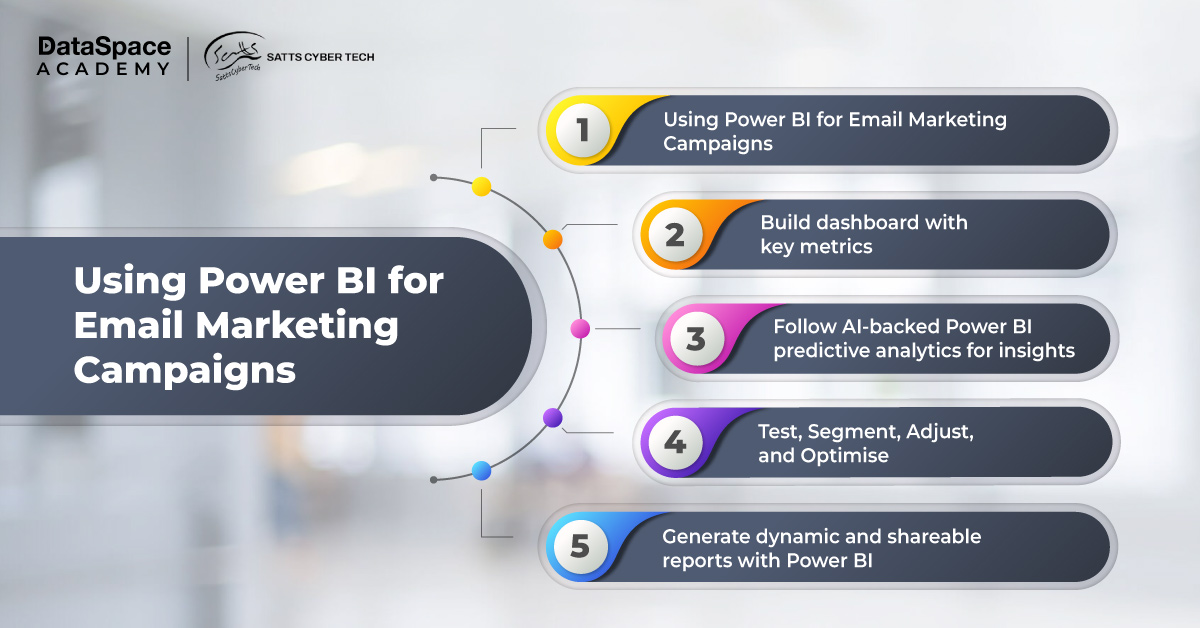Email marketing is a powerful tool—until you’re left staring at a mountain of campaign data, unsure of what’s working and what’s tanking. This is
where Microsoft Power BI, a leading
power bi tool, comes to the rescue. Widely popular among marketers, it transforms raw data into clear, insightful dashboards, helping businesses optimise their
email marketing campaigns like never before.
Let’s dive into how using Power BI can help marketers unlock the full potential of their email marketing.

Analysing an
email campaign report manually could be tedious, prone to errors, and often incomplete.
Power BI visualizations make it easy to track performance, discover trends, and make data-driven decisions. Here’s why it’s a must-have for marketing teams:

Now that we know the
use of Power BI in marketing, let’s break down how to set up an
email marketing campaign analysis effectively.
Step 1: Connect Your Email Marketing Data
Before anything, connect your
email marketing campaign tools (like HubSpot, Mailchimp, or Marketo) to Power BI. You can do this using built-in connectors or importing CSV reports from
best email campaign tools.
Step 2: Build a Dashboard with Key Metrics
Once your data is in, set up a dashboard that tracks:
Using
Power BI visualizations, marketers can filter these insights dynamically for deeper analysis.
Step 3: Use AI and Predictive Insights
Want to improve your
email marketing campaign strategy? AI-backed
Power BI predictive analytics can identify which email subject lines, times of day, or customer segments will yield the highest engagement.
Step 4: Optimise & Improve Your Campaigns
With all your insights in place, it’s time to act:
Step 5: Generate Reports and Share Insights
Finally, use
Power BI reporting to create dynamic, shareable reports for your team. Whether it’s about presenting findings to executives or refining your marketing strategy, having a visually compelling
email campaign report is invaluable.
In the ever-evolving world of digital marketing, relying on guesswork is no longer an option.
Using Power BI for
email marketing analytics ensures that businesses can make data-driven decisions, maximise campaign performance, and stay ahead of the competition.
For those looking to deepen their expertise, obtaining a
Microsoft Power BI certification can help master advanced data analysis skills. You can also consider enrolling in DataSpace Academy’s
Power BI course to sharpen your data interpretation and reporting abilities.
Transform your
email marketing campaign process with
Power BI analysis—because smarter data means smarter marketing.

 Analysing an email campaign report manually could be tedious, prone to errors, and often incomplete. Power BI visualizations make it easy to track performance, discover trends, and make data-driven decisions. Here’s why it’s a must-have for marketing teams:
Analysing an email campaign report manually could be tedious, prone to errors, and often incomplete. Power BI visualizations make it easy to track performance, discover trends, and make data-driven decisions. Here’s why it’s a must-have for marketing teams:
 Now that we know the use of Power BI in marketing, let’s break down how to set up an email marketing campaign analysis effectively.
Step 1: Connect Your Email Marketing Data
Before anything, connect your email marketing campaign tools (like HubSpot, Mailchimp, or Marketo) to Power BI. You can do this using built-in connectors or importing CSV reports from best email campaign tools.
Step 2: Build a Dashboard with Key Metrics
Once your data is in, set up a dashboard that tracks:
Now that we know the use of Power BI in marketing, let’s break down how to set up an email marketing campaign analysis effectively.
Step 1: Connect Your Email Marketing Data
Before anything, connect your email marketing campaign tools (like HubSpot, Mailchimp, or Marketo) to Power BI. You can do this using built-in connectors or importing CSV reports from best email campaign tools.
Step 2: Build a Dashboard with Key Metrics
Once your data is in, set up a dashboard that tracks:
